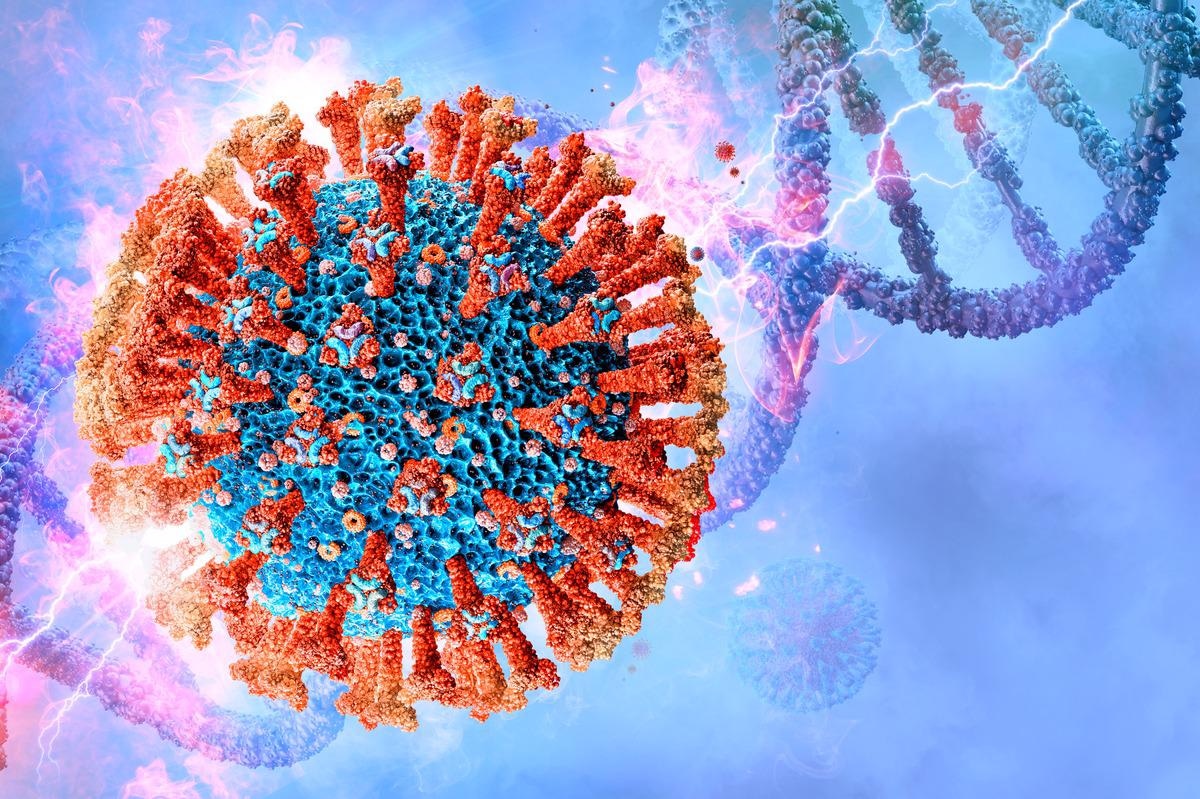The outbreak of a novel coronavirus, namely, Severe Acute Respiratory Syndrome Coronavirus 2 (SARS-CoV-2), has caused the coronavirus disease 2019 (COVID-19) pandemic. SARS-CoV-2 was first reported in a pneumonia-infected patient in Wuhan, China in 2019. Scientists have determined SARS-CoV-2 to be an RNA virus belonging to the genus Betacoronavirus of the family Coronaviridae.
 Study: Computational construction of a glycoprotein multi-epitope subunit vaccine candidate for old and new South-African SARS-CoV-2 virus strains. Image Credit: Corona Borealis Studio/Shutterstock
Study: Computational construction of a glycoprotein multi-epitope subunit vaccine candidate for old and new South-African SARS-CoV-2 virus strains. Image Credit: Corona Borealis Studio/Shutterstock
Background
To date, SARS-CoV-2 has claimed more than 5.5 million lives worldwide. Countries such as the United States of America, India, South Africa, and Brazil have been badly affected by the COVID-19 pandemic.
According to some reports from the World Health Organization (WHO), 50.87% of total COVID-19 cases in Africa are from South Africa. In 2020, the B.1.351 strain of SARS-CoV-2, which is commonly known as the Beta variant, was first reported in South Africa. This variant became the dominant circulating variant throughout the world and was classified as a variant of concern by WHO.
The Beta variant has been characterized as a highly virulent and transmissible strain. Another concerning factor of this strain is that it cannot be neutralized effectively by convalescent plasma and the sera of people who have been inoculated with different vaccines.
In a new study published in Informatics in Medicine Unlocked, scientists focused on the SARS-CoV-2 Beta variant because it is one of the first variants of concern(VOC). Additionally, scientists are concerned about the continual emergence of new variants in South Africa.
To combat this threat, researchers have used computational methods to design and develop effective glycoprotein multi-epitope subunit vaccine candidates, based on the old and the new Beta virus strains that emerged in South Africa. In this study, scientists focused on the genomic sequence data between 2020 and early 2021.
This new study offers a viable platform to develop country-specific COVID-19 vaccines. In this study, researchers have focused on developing vaccine candidates specifically against the South African SARS-CoV-2 variants. Scientists selected spike-like glycoprotein as a potential component for vaccine design because of its ability to produce efficient and effective vaccine candidates without any allergic reactions.
A new study
In many instances, scientists have used computational genomics and immunoinformatic methods to develop solutions to combat various diseases. Several studies have focused on the computational design of glycoprotein multi-epitope subunit vaccine candidates.
However, no documents on the computational design of vaccine candidates, efficient against the old and new South African SARS-CoV-2 variants existing between 2020 are 2021, have been found.
In this study, researchers used computational methods to develop a glycoprotein multi-epitope vaccine for all the SARS-CoV 2 variants found in South Africa. They have especially focused on the Beta variant, which is within the GH clades.
All the sequences were obtained from the GISAID database. Scientists explained that variation in a lineage occurs due to mutation, i.e., deletion or insertion of amino acids in the genomic RNA. Continual mutations occur in the SARS-CoV-2 genome because of the absence of the proofreading capacity of its open reading frame. Most of the isolates associated with this study belonged to clade GH and GR, whereas C2 and S are the lowest reported lineages.
Although the spike glycoprotein is considered to be a conserved sequence, it undergoes mutation. As an example, one could consider the mutation at the D614G position on the SARS-CoV-2 genome. Epitopes are the antigenic determinants that are used in vaccine design as they can elicit a cell-mediated immune response. Scientists have stated that cell-mediated immune response (CMI) can destroy virus-infected cells most efficiently. The determinants of adaptive and humoral responses are B-cells. Characteristic features of a good vaccine are its robust safety profile, anti-antigen, anti-allergen, and ability to elicit a strong immune response. The molecule size of an epitope is important because it determines the route of administration.
This epitope structure was validated by Ramachandran plot analysis, which revealed that 88.6% of the residue was in favorable regions. The grand average of hydropathicity (GRAVY) score of the newly constructed epitope was estimated to be −0.129, denoting a hydrophilic protein. Researchers used a molecular dynamics simulation study to determine the stability, mobility, atoms, and molecules movements of the vaccine candidate. They also used molecular docking using ClusPro 2 to determine the binding efficiency and the interaction between the refined model and the toll-like receptor (TLR). TLR detects the structural and non-structural viral proteins, which induce the production of inflammatory cytokines. Researchers found that the increase in the memory cells was steady over time. Additionally, B-cells remained active over a longer period. In silico immune analysis showed that all the immune secretions were consistent with the characteristic features of established immunity.
Conclusion
The authors stated that these findings will be beneficial for biologists, governments, and pharmaceutical companies to effectively manage the newly emerging COVID-19 variants in South Africa.
The vaccine candidate could efficiently reduce the transmission of the virus within a country and, therefore, protect individuals from SARS-CoV-2 infection.
In the future, the authors aim to determine and analyze the new SARS-CoV-2 variants from South Africa to design effective vaccine candidates.